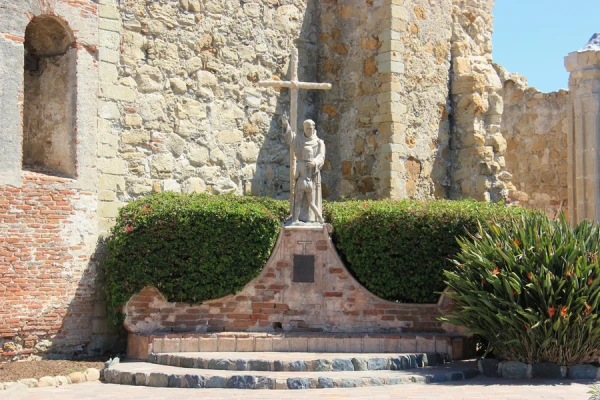
CNA Staff, Jun 25, 2020 / 04:34 pm (CNA).- Two statues of St. Junipero Serra have been moved from a Catholic mission and church in southern California amid fears of vandalism as protests around the state continue to topple statues.
The Mission San Juan Capistrano and its neighboring church have removed statues of Serra from their outside displays this week.
Diocese of Orange spokeswoman Tracey Kincaid told the OC Register that the Mission Basilica San Juan Capistrano moved the statue “out of precaution.” The statue, which was anchored to a pedestal at the entrance, was removed on June 23.
The mission next door relocated the statute from its front courtyard to its Sala building. The 104-year-old statue has been displayed for almost 80 years. It will soon be part of a mission exhibit on the life of Serra.
“The statue was moved to ensure its protection and was relocated to also ensure its continued access to the public,” mission staff said in a June 24 Facebook post.
The basilica was built in 1986 to accommodate the growing Catholic community, which outgrew the mission’s smaller Serra Chapel. The Mission San Juan Capistrano was established by Serra in 1776.
Serra statues are among numerous depictions of historic figures pulled down in the past week amid ongoing protests and riots throughout the country. While some protests have torn down the statues of Confederate figures, as part of a call to end systemic racism, other statues have also been torn down from prominent locations, including one of George Washington.
During the eighteenth century, Serra founded nine Catholic missions in the area that would later become California, many of those missions would go on to become the centers of major California cities.
Serra helped to convert thousands of native Californians to Christianity and taught them new agricultural technologies. Critics have lambasted Serra as a symbol of European colonialism and said the missions engaged in the forced labor of Native Americans, sometimes claiming Bl. Serra himself was abusive.
But Serra’s defenders say that Serra was actually an advocate for native people and a champion of human rights. They note the many native people he helped during his life, and their outpouring of grief at his death.
Biographers note that Serra frequently intervened for native people when they faced persecution from Spanish authorities. In one case, the priest intervened to spare the lives of several California natives who had attacked a Spanish outpost.
Archbishop Salvatore Cordileone of San Francisco issued a June 20 statement highlighting the saint’s good works, saying, “St. Serra made heroic sacrifices to protect the indigenous people of California from their Spanish conquerors, especially the soldiers…”
“For the past 800 years, the various Franciscan orders of brothers, sisters and priests that trace their inspiration back to him have been exemplary of not only serving, but identifying with, the poor and downtrodden and giving them their rightful dignity as children of God,” the archbishop said.
The California Catholic Conference of Bishops similarly defended Serra, saying, “The historical truth is that Serra repeatedly pressed the Spanish authorities for better treatment of the Native American communities. Serra was not simply a man of his times.”
“In working with Native Americans, he was a man ahead of his times who made great sacrifices to defend and serve the indigenous population and work against an oppression that extends far beyond the mission era,” they said.
“And if that is not enough to legitimate a public statue in the state that he did so much to create, then virtually every historical figure from our nation’s past will have to be removed for their failings measured in the light of today’s standards.”
If you value the news and views Catholic World Report provides, please consider donating to support our efforts. Your contribution will help us continue to make CWR available to all readers worldwide for free, without a subscription. Thank you for your generosity!
Click here for more information on donating to CWR. Click here to sign up for our newsletter.




Ok. This is confusing for me. I don’t understand why today, when people come from other lands (immigration) for any number of reasons this is always seen as a good, regardless of circumstances and something we should welcome, of course….but whenever we discuss various types of Europeans who long ago were coming to this country and establishing lives for themselves, for various reasons, they are automatically characterized as Terrible, awful, colonizers who stole the land and destroyed the cultures living here..??? Why the overarching double standards and broad generalizations? And why the refusal to examine critically the violence and injustice among the cultures of Native peoples, and place that into the context of the discussion?